CONSOLIDATED FINANCIAL STATEMENTS OF ADORN
Published on July 5, 2007
Exhibit 99.1
INDEPENDENT AUDITORS REPORT
To the Board of Directors and Shareholders of
Adorn Holdings, Inc.
We have audited the accompanying consolidated balance sheets of Adorn Holdings, Inc. and subsidiaries (the Company) as of December 31, 2006 and 2005, and the related consolidated statements of operations, shareholders equity, and cash flows for each of the three years in the period ended December 31, 2006. These financial statements are the responsibility of the Companys management. Our responsibility is to express an opinion on these financial statements based on our audits.
We conducted our audits in accordance with auditing standards generally accepted in the United States of America. Those standards require that we plan and perform the audit to obtain reasonable assurance about whether the financial statements are free of material misstatement. An audit includes consideration of internal control over financial reporting as a basis for designing audit procedures that are appropriate in the circumstances, but not for the purpose of expressing an opinion on the effectiveness of the Companys internal control over financial reporting. Accordingly, we express no such opinion. An audit also includes examining, on a test basis, evidence supporting the amounts and disclosures in the financial statements, assessing the accounting principles used and significant estimates made by management, as well as evaluating the overall financial statement presentation. We believe that our audits provide a reasonable basis for our opinion.
In our opinion, such consolidated financial statements present fairly, in all material respects, the financial position of the Company as of December 31, 2006 and 2005, and the results of its operations and its cash flows for each of the three years in the period ended December 31, 2006, in conformity with accounting principles generally accepted in the United States of America.
As discussed in Note 14, the accompanying 2005 and 2004 consolidated financial statements have been restated.
/S/ DELOITTE & TOUCHE LLP
Cleveland, Ohio
April 23, 2007 (May 18, 2007 as to Note 13)
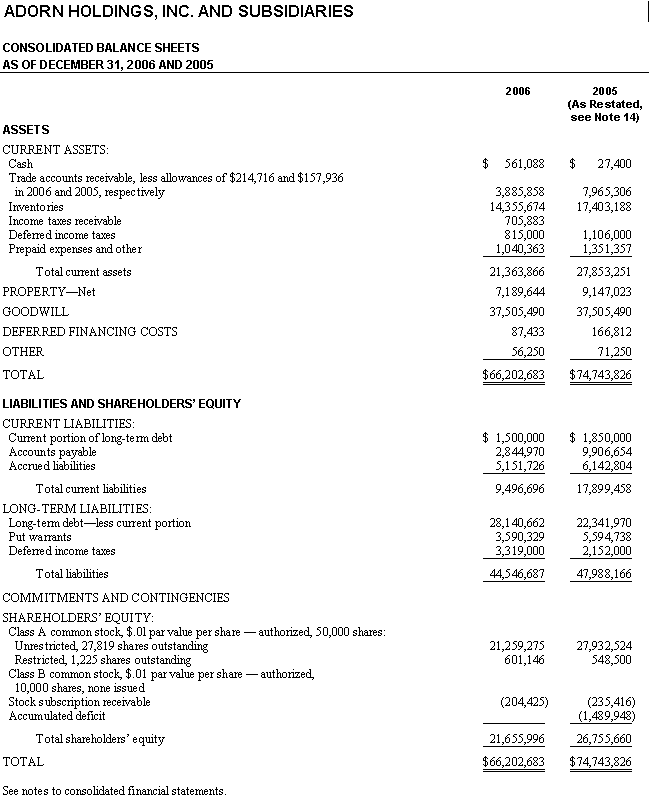
- 2 -

- 3 -

See notes to consolidated financial statements.
- 4 -

- 5 -
ADORN HOLDINGS, INC. AND SUBSIDIARIES
NOTES TO CONSOLIDATED FINANCIAL STATEMENTS
|
1. |
DESCRIPTION OF BUSINESS AND ACQUISITION |
Description of BusinessAdorn Holdings, Inc. (Holdings), through its wholly-owned subsidiary, Adorn, LLC (LLC), (collectively, the Company) manufactures decorative paneling, battens, stiles, counter tops, cabinets, laminated wallboards and slot wall products for the manufactured housing and recreational vehicle industries and sells to customers throughout the United States. The Companys principal operating facilities are located in Elkhart, Indiana; Bear Creek, Alabama; Adel, Georgia; Madisonville, Tennessee; Grand Prairie, Texas; New London, North Carolina; Bensenville, Illinois; and Tualatin, Oregon. The majority of the capital stock of Holdings (see Note 9) is owned by a private investment fund.
Sales to the Companys two largest customers constituted 17% and 15%, respectively, of the Companys net sales for the year ended December 31, 2006; 17% and 13%, respectively, of net sales for the year ended December 31, 2005; and 18% and 11%, respectively, of net sales for the year ended December 31, 2004. In addition, 24%, 10%, and 10% of the Companys trade accounts receivable was due from these customers at December 31, 2006, 2005 and 2004, respectively.
The Company purchased 24% and 14% of its raw materials from two vendors, respectively, during the year ended December 31, 2006; 21% and 14% of its raw materials from these vendors during the year ended December 31, 2005; and 22% and 13% of its raw materials from these vendors during the year ended December 31, 2004.
AcquisitionDuring September 2005, the Company acquired, for approximately $1.5 million, substantially all of the assets (principally inventory and equipment) of a business in Bear Creek, Alabama that is engaged in the manufacturing and selling of laminated gypsum and wood products. In addition to the acquisition of approximately $.8 million of inventory and $.5 million of equipment, the Company recognized approximately $.2 million of goodwill and other intangible assets in accounting for the transaction, all of which is expected to be deductible for income tax purposes. The Company accounted for the acquisition as a purchase and has included the results of operations of the acquired organization in its consolidated financial statements from the effective date of the acquisition. Because the operations of the acquired business are not significant, pro forma disclosure of the combined operating results of the Company and the acquired business are not presented.
|
2. |
SUMMARY OF SIGNIFICANT ACCOUNTING POLICIES |
Principles of ConsolidationThe consolidated financial statements include the accounts of Adorn Holdings, Inc. and its subsidiary Adorn, LLC. All significant intercompany balances and transactions are eliminated in consolidation.
EstimatesThe preparation of the consolidated financial statements in conformity with accounting principles generally accepted in the United States of America requires management to make estimates and assumptions that affect the reported amounts of assets and liabilities and disclosure of contingent assets and liabilities at the date of the consolidated financial statements and the reported amounts of revenues and expenses during the reporting period. Actual results could differ from those estimates.
- 6 -
Accounts Receivable AllowancesThe Company provides allowances for losses estimated to be incurred on existing trade accounts receivable and miscellaneous credits due to customers. The allowances are based on historical collection experience and specific identification. Credit limits, ongoing credit evaluations, and account monitoring procedures are utilized to minimize the risk of loss. Collateral is generally not required.
InventoriesInventories are valued at the lower of cost or market, determined by the first-in, first-out (FIFO) method. Management evaluates inventories to determine obsolete, slow-moving and excess inventory. A provision for potentially unsaleable or unusable inventory is recorded as a part of cost of goods sold.
PropertyProperty is stated at cost, less accumulated depreciation. Additions, renewals and betterments are capitalized; maintenance and repairs, which do not extend the useful life of the asset, are expensed as incurred. Depreciation is computed using the straight-line method over the estimated useful lives of the assets, generally forty years for buildings and improvements, seven years for machinery and equipment, five years for vehicles and computer equipment, three years for tooling and computer software, and five to seven years for furniture and fixtures. The cost of leasehold improvements is depreciated over the shorter of the estimated useful lives of the improvements or the terms of the related leases.
The Company assesses the potential impairment of its property by determining whether the carrying value of the property can be recovered through projected, undiscounted cash flows from future operations over the propertys remaining estimated useful life. Any impairment recognized is the amount by which the carrying value exceeds the fair value of the asset.
GoodwillGoodwill is not amortized. Instead, goodwill is tested for impairment at least annually. A two-step impairment test is used to identify potential goodwill impairment. The first step of the goodwill impairment test, used to identify potential impairment, compares the fair value of a reporting unit (as defined) with its carrying amount, including goodwill. If the fair value of the reporting unit exceeds its carrying amount, goodwill is not considered impaired, and the second step of the goodwill impairment test is unnecessary. The second step measures the amount of impairment, if any, by comparing the carrying value of the goodwill associated with a reporting unit to the implied fair value of the goodwill derived from the estimated overall fair value of the reporting unit and the individual fair values of the other assets and liabilities of the reporting unit. The Companys annual impairment test is performed as of its year end and no impairment was recognized during 2006, 2005, or 2004.
Debt Issue Costs and Original Issuance DiscountsThe cost of obtaining financing, as well as original issuance discounts, are amortized using the interest method over the terms of the respective obligations/securities.
Revenue RecognitionSales and related cost of goods sold are recognized upon shipment of products to customers. Customers have the right to return defective items purchased. The Company records an allowance for customer returns based on return activity. Provisions for sales discounts and rebates from customers are recorded, based on the terms of sales arrangements, in the same period the related sales are recorded, as a reduction of sales.
Revenues include amounts billed to customers for freight. Shipping and handling costs are included in cost of goods sold.
- 7 -
Income TaxesDeferred income taxes are recognized for the expected future tax consequences of events that have been recognized in the consolidated financial statements or tax returns. Deferred tax assets and liabilities are determined based on the difference between the financial statement and tax bases of various assets and liabilities using enacted rates in effect for the year in which the differences are expected to reverse. A valuation allowance is provided when it is more likely than not that some or all of a deferred tax asset will not be realized.
Comprehensive Income (Loss)The term comprehensive income (loss) represents the change in the shareholders equity of the Company from transactions and other events and circumstances resulting from non-shareholder sources. The Companys comprehensive income (loss) includes its net income plus or minus the change in the fair value of its interest rate swaps (net of the effect of income taxes), which is recorded directly in shareholders equity and is not included in net income or loss.
Put WarrantsThe Company has recorded a liability for the estimated fair value of the detachable put warrants issued in conjunction with its senior subordinated notes and is recognizing changes in the estimated fair value in earnings. The fair value of the put warrants was estimated by management of the Company based on discounted cash flow models as well as historical earnings trends and other market information.
Stock-Based CompensationThe Company has a stock-based employee compensation plan, which is described more fully in Note 9. The Company has historically accounted for this plan under the recognition and measurement principles of Statement of Financial Accounting Standards (SFAS) No. 123, Accounting for Stock-Based Compensation, and, accordingly, measured compensation expense under the plan based on the estimated fair values of the awards on the grant dates and amortized the expense over the options vesting periods. In December 2004, SFAS No. 123 was reissued as SFAS No. 123R, Share-Based Payment, which also requires measurement of compensation cost for all equity-based awards at fair value on the date of grant and recognition of compensation expense over the service period for awards expected to vest. The Company adopted SFAS No. 123R effective January 1, 2006. Generally, the approach in SFAS No. 123R is similar to the fair value approach described in SFAS No. 123, except that the use of the minimum value method of measuring the fair value of stock options and similar instruments for recognition purposes under SFAS No.123 is no longer permitted and the cash flows from tax benefits resulting from tax deductions in excess of compensation costs recognized for stock options must be classified as financing cash flows in the consolidated statement of cash flows, rather than as cash flows from operating activities. As permitted under SFAS No. 123R, the Company has continued to account for the awards outstanding at the date of initial application of the pronouncement using the accounting principles originally applied to those awards (the minimum value method under SFAS No.123 and its related interpretive guidance). No stock-based compensation awards were issued by the Company in 2006. Accordingly, the adoption of SFAS No.123R did not have an effect on the Companys consolidated financial statements.
Interest Rate SwapsThe Companys interest rate swaps, which represented cash flow hedges of the variable interest rate exposure on a portion of the Companys long-term debt, were recognized as either assets or liabilities in the Companys consolidated balance sheet at fair value until they matured in 2005. Unrealized gains and losses resulting from changes in the fair value of the swaps were recorded as a separate component of shareholders equity because the swaps met the criteria for cash flow hedge accounting. The fair value of the Companys interest rate swaps is estimated by management based on quotes received from financial institutions.
- 8 -
New Accounting PronouncementsIn July 2006, the Financial Accounting Standards Board (FASB) issued FASB Interpretation No. 48, Accounting for Uncertainty in Income Taxes, an interpretation of FASB Statement No. 109, (FIN 48). FIN 48 prescribes the minimum accounting and disclosure requirements of uncertain tax positions. FIN 48 also provides guidance on derecognition, measurement, classification, interest and penalties, and transition of uncertain tax positions. FIN 48 is effective for fiscal periods beginning after December 15, 2006. FIN 48 requires the cumulative effect of applying its provisions to be reported separately as an adjustment to the opening balance of retained earnings in the year of adoption. The Company is currently in the process of determining the expected impact, if any, of adoption of FIN 48 on its consolidated financial statements.
In June 2005, the FASB issued SFAS No. 154, Accounting Changes and Error CorrectionsA Replacement of APB Opinion No. 20 and FASB Statement No. 3. This Statement requires that a voluntary change in accounting principle be applied retrospectively with all prior period financial statements presented on the basis of the new accounting principle, unless it is impracticable to do so. SFAS No. 154 also provides that (1) a change in method of depreciating or amortizing a long-lived nonfinancial asset be accounted for as a change in estimate (prospectively) that was effected by a change in accounting principle, and (2) correction of errors in previously issued financial statements should be termed a restatement. The new standard is effective for accounting changes and corrections of errors made in fiscal years beginning after December 15, 2005. Early adoption of this standard is permitted for accounting changes and correction of errors made in fiscal years beginning after June 1, 2005. The Company has adopted the provisions of this statement for fiscal 2006 and, accordingly, has referred to the correction of an error in previously issued financial statements as a restatement (see Note 14). The adoption of the provisions of this statement had no other impact on the accompanying consolidated financial statements.
In September 2006, the FASB issued SFAS No. 157, Fair Value Measurements. This statement establishes a framework for measuring fair value and expands disclosures about fair value measurements. This statement does not require any new fair value measurements not previously required under other accounting pronouncements. SFAS No. 157 is effective for fiscal periods beginning after November 15, 2007. SFAS No. 157 requires adoption prospectively as of the beginning of the fiscal year in which this statement is initially applied, with the exception of certain financial instruments in which adoption must be applied retrospectively as of the beginning of the fiscal year in which the statement is initially applied. The Company is currently in the process of determining the expected impact, if any, of adoption of SFAS No. 157 on its consolidated financial statements.
In February 2007, the FASB issued SFAS No. 159, The Fair Value Option for Financial Assets and Financial Liabilities, which permits entities to choose to measure many eligible financial instruments and certain other items at fair value, with related unrealized gains and losses included in earnings. This pronouncement provides entities the opportunity to mitigate volatility in reported earnings caused by measuring related assets and liabilities differently without having to comply with the complex hedge accounting requirements. SFAS No. 159 is effective for fiscal periods beginning after November 15, 2007. The Company is not permitted to apply this statement retrospectively to fiscal years preceding the effective date unless it chooses early adoption. The Company is currently in the process of determining the expected impact, if any, of the adoption of SFAS No. 159 on its consolidated financial statements.
- 9 -
|
3. |
INVENTORIES |
Inventories at December 31, 2006 and 2005, consist of the following:

|
4. |
PROPERTY AND LEASES |
Property at December 31, 2006 and 2005, consists of the following:

Construction in progress is composed of various recently acquired items of machinery and equipment that were not in service at the end of the year. In addition, approximately $457,900 of trade accounts payable at December 31, 2005, relates to the purchase of property. No such amounts were included in accounts payable at December 31, 2006.
The Company recognized depreciation expense of $2,989,579, $2,751,693, and $2,852,388 in 2006, 2005, and 2004, respectively.
- 10 -
The Company leases eleven of its operating facilities, two of which are leased from an entity controlled by one of the Companys shareholders. The Company also leases certain equipment, tractors and other vehicles from unrelated parties. All of the Companys leases are accounted for as operating leases. Total rent expense recognized by the Company under the operating leases was $3,530,548 for 2006, $3,478,177 for 2005 and $3,471,736 for 2004. The Companys remaining commitments under noncancelable leases at December 31, 2006, were as follows:

|
5. |
ACCRUED LIABILITIES |
SummaryAccrued liabilities at December 31, 2006 and 2005, consist of the following:

Product WarrantiesThe Company provides limited warranties in connection with the sale of its products. The warranty period for products sold varies, ranging from 1 to 2 years; however, the warranty period for the majority of the Companys sales generally does not exceed 2 years. The costs incurred by the Company pertaining to product warranty matters are generally not significant; however, during 2003, the Company was notified that a product designed by a major customer and manufactured and sold by the Company (principally in 2001 and 2002) was experiencing an unusually high rate of failure. In response to this matter, the Company began the process of participating with the customer in an effort to either replace the product, which had been installed on approximately 2,300 manufactured homes throughout the United States, or otherwise compensate the homeowners for the potential defect. Substantially all of the Companys product warranty liability summarized in the table below applies to this matter. Although there can be no assurance that the future costs of this issue will not exceed the accrual the Company has established, management believes that the Companys accrued liability at December 31, 2006, is adequate to cover such costs.
- 11 -
A reconciliation of changes in the product warranty liability for the years ended December 31, 2006, 2005 and 2004 is presented in the following table:
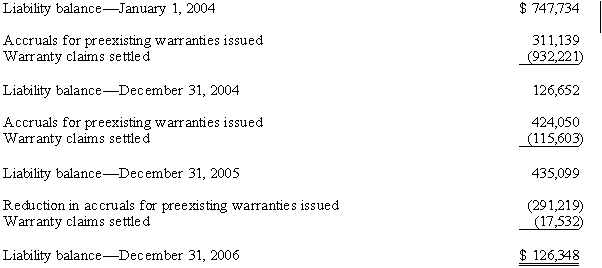
|
6. |
DEBT |
SummaryThe Companys long-term debt at December 31, 2006 and 2005, consists of the following:
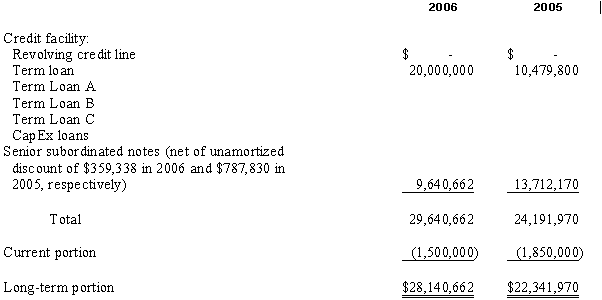
RefinancingsIn February 2005, the Companys credit facility was amended to permit the refinancing of the term and the CapEx loans, extend the maturity of the revolving credit line and modify various other provisions of the credit facility. Accordingly, on February 28, 2005, the remaining outstanding $12.5 million balance under the Companys term and CapEx loans, along with $0.1 million of related costs, were repaid from the proceeds of a new $12.0 million Term Loan and $0.6 million of borrowings under the Companys revolving credit line. The amendment also: (1) reduced the total amount of the revolving credit line from $20 million to $18 million but extended its maturity to February 2008, (2) reduced the Applicable margin component of the Base Rate and LIBOR interest rate options and (3) revised certain financial covenants and other terms.
- 12 -
In December 2006, the Companys credit facility was further amended to provide additional borrowing capacity and modify certain restrictive covenants to permit the Company to immediately repay $4.5 million of its senior subordinated notes and make a special $12.5 million distribution to the Companys shareholders and warrant holders of $11,516,307 and $983,693, respectively. The repayment of the senior subordinated notes and special distribution to shareholders and warrant holders was financed through $11.4 million of additional term loan borrowings and the use of $5.6 million of existing cash balances. The early repayment of a portion of the senior subordinated notes resulted in the recognition of a $.5 million pre-tax charge in 2006, which includes the fees incurred in connection with the transaction and the write-off of unamortized debt discount and issue costs pertaining to the portion of the debt repaid and is reflected as a refinancing expense in the accompanying consolidated statement of operations for the year ended December 31, 2006.
Credit FacilityThe amendment to the credit facility executed in 2006 increased the borrowings available under the facility, extended the maturity of the revolving credit line and term loan, and modified various other provisions of the credit facility. The revised term loan is payable through December 2011 and bears interest at either a floating Base Rate or LIBOR rate. The required annual principal payments for the revised term loan are as follows: 2007$1,500,000; 2008$2,000,000; 2009$2,000,000; 2010$2,000,000 and 2011$12,500,000.
The amendment also: (1) increased the total amount of the revolving credit line from $18 million to $20 million and extended its maturity to December 2011, (2) decreased the Applicable Margin component of the Base Rate and LIBOR interest rate options and (3) revised certain financial covenants and other terms. At December 31, 2006 and 2005, the Company had outstanding letters of credit totaling $780,000 and $360,000, respectively. At December 31, 2006, $19,220,000 of additional borrowings were available under the revolving credit line.
The interest rates charged under the credit facility are, at LLCs option, either (1) a floating rate equal to the Base Rate (greater of Prime Rate or one half of one percent in excess of the Federal Funds Effective Rate) plus the Applicable Margin (depending upon the type of loan under the credit facility and the Companys leverage ratio, as defined); or (2) the LIBOR rate for fixed periods of one, two, three, or six months, plus the Applicable Margin (depending upon the type of loan under the credit facility and the Companys leverage ratio, as defined). The credit facility is subject to mandatory prepayment from the proceeds of certain asset sales, the proceeds of certain debt or equity offerings, and 75% of excess cash flow (as defined in the credit facility). The weighted average interest rate on the outstanding borrowings under the credit facility at December 31, 2006 and 2005 was 8.6% and 7.18%, respectively.
All obligations under the credit facility are guaranteed by Holdings. In addition, substantially all of LLCs assets serve as collateral for the Companys obligations under the credit facility. The credit facility contains a number of restrictive covenants that, among other things, restrict certain actions of LLC, including mergers, sales and leasing of assets, granting of liens, incurrence of indebtedness, capital expenditures, repurchase of stock and payment of dividends, investments and acquisitions, and transactions with affiliates (including management fees). The credit facility also requires LLC to comply with certain financial covenants pertaining to leverage, fixed charge coverage, interest coverage, operating cash flow (as defined), capital expenditures and leasing arrangements. The Company has received an extension of the deadline for submitting audited financial statements to the lender.
Interest Rate SwapsIn the ordinary course of business, the Company borrows cash under long-term debt agreements to fund its acquisitions. Prior to their maturity in 2005, three interest rate exchange agreements (swaps) were used to limit the Companys interest rate exposure on a portion of its variable rate long-term debt. The swaps provided for interest to be received based on notional amounts at variable rates and provided for interest to be paid on the same notional amounts at fixed rates. The
- 13 -
fixed interest rates did not change over the life of the agreements. These swap agreements effectively changed the base interest rate exposure on $4.6 million of loans to a fixed rate of 7.14% through April 2004, $5.4 million of loans to a fixed rate of 7.21% through April 2005 and $2.1 million of loans to a fixed rate of 5.38% through April 2005.
The Company designated its interest rate swaps as cash flow hedges of the variability in forecasted interest payments under SFAS Nos. 133 and 138. Accordingly, the $155,793 and $567,471 of unrealized appreciation in the fair value of the swaps during the years ended December 31, 2005 and 2004, respectively, were recorded as other comprehensive income, net of income taxes of $59,200 and $215,640, respectively. Because the swaps were effective as cash flow hedges, the unrealized change in their fair value during 2005 and 2004 had no effect on the Companys net income reported for those years.
Senior Subordinated Notes and Detachable WarrantsIn conjunction with the formation of the Company in February 2000, the Company also issued $14.5 million of senior subordinated notes (the Notes), to a financial institution, $4.5 million of which was repaid in connection with the refinancing. The Notes bear interest at an annual rate of 12.5% and are obligations of Holdings and LLC, ranking subordinate to the Companys senior debt, as defined in the Subordination Agreement. The remaining Notes mature as follows: 2008$4,834,000, 2009$4,834,000, and 2012$332,000. The Notes are redeemable in advance of their maturity, in whole or in part. If a change in control of the Company occurs, the holders of the Notes will have the right to demand that the Company redeem the Notes, plus accrued interest. The restrictive covenants included in the Notes are similar to the restrictive covenants included in the credit facility. The Company has received an extension of the deadline for submitting audited financial statements to the lender.
The purchasers of the Notes were provided detachable put warrants to purchase 2,480.86 shares of Class B common stock of Holdings at a price of $.02 per share. The put warrants are exercisable at any time through June 1, 2012. In the event of a change in the control of the Company, as defined, the holders of the put warrants, as well as any shares acquired with the put warrants, will have the right to exercise a put option requiring the Company to repurchase all or a portion of the put warrants or related common shares at fair value. The estimated fair value of the put warrants is included as a liability in the accompanying consolidated balance sheets. The difference between the stated principal amount of the notes and their carrying value represents an original issue discount which is being amortized using the interest method. As described in the provisions of the put warrants, the special distribution to shareholders described previously and in Note 9 resulted in a required payment to the warrant holders of $983,693.
|
7. |
EMPLOYEE RETIREMENT PLAN |
The Company has a 401(k) plan covering substantially all of its employees who have in excess of six months of service. The Company provides for Company matching contributions of up to 1% of participating employees base pay. The expense recognized for contributions to the plan was $109,942, $104,712, and $22,027 for 2006, 2005 and 2004, respectively.
- 14 -
|
8. |
INCOME TAXES |
The Companys income tax provision for the years ended December 31, 2006, 2005 and 2004, consists of the following:

The income tax provision differs from the amount computed by applying the U.S. federal statutory income tax rate of 34% to the Companys income before income taxes and cumulative effect of change in accounting principle as detailed below for the years ended December 31, 2006, 2005 and 2004:

- 15 -
The components of the Companys deferred income tax balances at December 31, 2006 and 2005, are as follows:
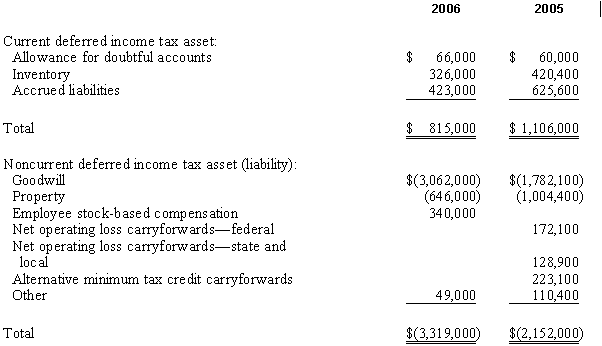
|
9. |
CAPITAL STOCK AND OPTIONS |
Preferred StockIn conjunction with an amendment of its credit facility in 2004, the Company also amended its Articles of Incorporation to permit the issuance of up to 20,000 Series A Preferred Shares (par value $.01) and 20,000 Series B Preferred Shares ($.01 par value). Dividends on the Series A Preferred Shares accumulate at the rate of 20% per annum until they are declared and paid. The Series A Preferred Shares also have a stated liquidation preference over the Companys common shares equal to the capital contributed to the Company in connection with the issuance of the preferred shares plus accumulated, unpaid dividends. The terms of the Series B Preferred Shares have not been finalized and no such shares have been issued.
In March 2005, the Company repurchased all 100 of its outstanding Series A Preferred Shares, including accumulated unpaid dividends, for approximately $1.2 million. This transaction was funded through additional borrowings under the Companys revolving credit line. No preferred stock was outstanding at December 31, 2006 or 2005.
Common StockAt December 31, 2006, the Company was authorized to issue 50,000 shares of voting Class A common stock with a par value of $.01 per share, and there were 27,819 shares of unrestricted Class A common stock issued and outstanding along with 1,225 restricted shares. The Company was also authorized to issue 10,000 shares of non-voting Class B common stock with a par value $.01 per share. There were no shares of Class B common stock issued and outstanding at December 31, 2006. Class B shares have limited voting rights and are convertible into Class A shares.
- 16 -
The Companys shareholders agreement specifies the procedures that must be followed before certain shareholders can sell any of their shares, including offering the shares for sale to the Company and other shareholders at a defined price before they can be sold to an outside party. The shareholders agreement also provides any employee shareholder the right, in certain employee termination situations, to put his or her shares back to the Company for cash equal to either the book value of the shares, as defined, or a value based on a multiple of earnings, as defined. In addition, the Company has the right to call employee shares under certain employee termination situations.
Stock OptionsUnder the terms of the Companys shareholder-approved stock option plan, the Company has reserved 1,122 of its Class A common shares for stock options, which can be granted to executive and key employees of the Company. The options generally vest upon: (1) a change in the control of the Company, or (2) certain specified dates in the option agreements. Unless terminated earlier, the options expire ten years from the date of grant. Stock options are generally granted with an exercise price equal to or greater than the estimated fair value of the Companys stock at the date of grant and, once the options are exercised, the shares are subject to transfer restrictions under the terms of Companys shareholders agreement. The Company believes that such awards better align the interests of its employees with those of its shareholders.
As of December 31, 2006, no stock options were available for future grants.
A summary of stock option activity under the Plan for the years ended December 31, 2006, 2005 and 2004, is presented below:
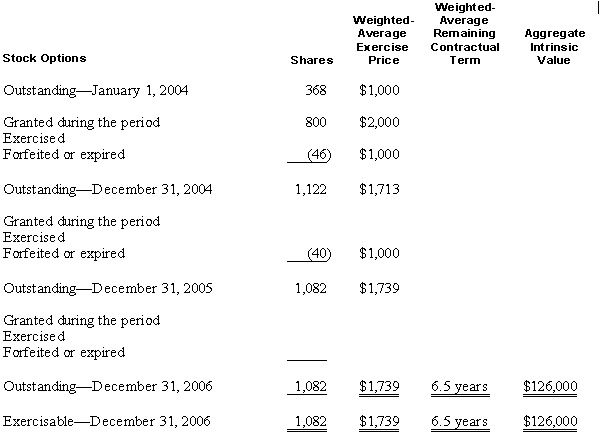
- 17 -
A summary of the status of the Companys non-vested options as of December 31, 2006, and changes during the year then ended is presented below:

No stock option-based compensation expense was recognized during the years ended December 31, 2006, 2005 and 2004. As of December 31, 2006, there was no unrecognized compensation cost related to nonvested share-based compensation arrangements granted under the Companys stock option plan. The fair value of each option granted during 2004 was nil based on the Black-Scholes option pricing model and the following assumptions: risk-free interest rate of 3%, expected option life equal to three years and expected volatility and dividend yield of 0%.
Restricted StockIn June 2004, the Company issued 1,225 shares of restricted Class A common stock (par value of $.01 per share) to certain members of the Companys management. The individuals to whom the restricted stock was granted are entitled to receive dividends declared on common shares and vote on corporate matters. The restricted stock cannot be sold prior to a change in the control of the Company, as defined, and the shares will be forfeited and returned to the Company if a recipient terminates their employment prior to such an event. The restricted shares are not subject to the provisions of the Companys shareholders agreement.
The Company is recognizing the estimated fair value of the restricted shares issued during 2004 as employee stock-based compensation expense evenly through the estimated point in time the restrictions are expected to lapse (three years after the grant date). Accordingly, employee stock-based compensation expense of $346,500, $346,500, and $202,000 was recognized during 2006, 2005 and 2004, respectively, from the restricted shares. As of December 31, 2006, there was $144,500 of total unrecognized compensation cost related to the restricted shares. This cost is expected to be recognized in 2007.
Distribution to ShareholdersIn connection with the refinancing in December 2006 discussed in Note 6, the Company distributed approximately $11.5 million to its shareholders, of which approximately $4.5 million was recognized as a dividend and $7.0 million as a return of capital.
|
10. |
RELATED-PARTY TRANSACTIONS |
On February 29, 2000, the Company entered into a Management Agreement with an organization affiliated with Holdings majority shareholder under which the organization is to provide general financial and management advisory services for a fee. Fees of $600,000, $600,000 and $650,000 were recognized as an expense by the Company during the years ended December 31, 2006, 2005 and 2004, respectively.
- 18 -
Lease payments to a real estate company controlled by a Holdings shareholder totaled $1,354,421 for 2006, $1,404,649 for 2005 and $1,409,834 for 2004.
|
11. |
CONTINGENCIES |
Lawsuits and claims are filed from time to time against the Company in the ordinary course of business. Management of the Company, after consultation with legal counsel, is of the opinion that the outcome of such matters will not have a material, adverse effect on the Companys consolidated financial condition, results of operations or liquidity.
|
12. |
FAIR VALUE OF FINANCIAL INSTRUMENTS |
The Company has various financial instruments, including cash, accounts receivable and payable, accrued liabilities, put warrants and long-term debt. The carrying value of the Companys cash, accounts receivable and payable, and accrued liabilities approximates their fair value due to the short-term nature of these assets and liabilities. The Companys put warrants and interest rate swaps are recorded at estimated fair value and the Company also believes that the aggregate fair value of its term loan approximates its carrying amount because the interest rate on the debt is reset on a frequent basis to reflect current market rates. The estimated fair value of the Companys senior subordinated notes at December 31, 2006 and 2005, approximated $10.2 million and $15.1 million, respectively. Because a ready market for the senior subordinated notes does not exist, the estimated fair value was derived from the market values and yields of publicly traded securities that are deemed to have similar risk characteristics and maturities.
|
13. |
SUBSEQUENT EVENT |
On May 18, 2007, Patrick Industries, Inc. acquired all of the common stock of Holdings in return for a cash payment of $76.7 million (excluding the costs of the transaction), at which time all of the Companys outstanding consolidated indebtedness, put warrants, and stock options were repaid/redeemed from the proceeds of the sale.
|
14. |
RESTATEMENT |
Subsequent to the issuance of the Companys fiscal 2005 and 2004 consolidated financial statements, the Companys management determined that, because of the put feature embedded within the Companys warrants (see Note 6), the fair value of its warrants should be recognized as a liability and the change in fair value during the year should be reflected in earnings to comply with the provisions of Financial Accounting Standards Board Staff Position FAS 150-1: Issuers Accounting for Freestanding Financial Instruments Composed of More Than One Option or Forward Contract Embodying Obligations under FASB Statement No. 150 (FSP 150-1). The Company had been reporting the warrants as a component of shareholders equity at their fair value on the date of issuance with no subsequent adjustments for changes in fair value.
Because the provisions of FSP 150-1 were effective for years beginning after October 16, 2003, the Company has restated its consolidated financial statements as of December 31, 2005, and for the years ended December 31, 2005 and 2004, to recognize the cumulative effect of the change in accounting principle as of January 1, 2004, and the subsequent changes in the estimated fair value of the warrants during 2005 and 2004.
- 19 -
The effect of this restatement on the 2005 and 2004 consolidated financial statements by financial statement line item affected is shown below:
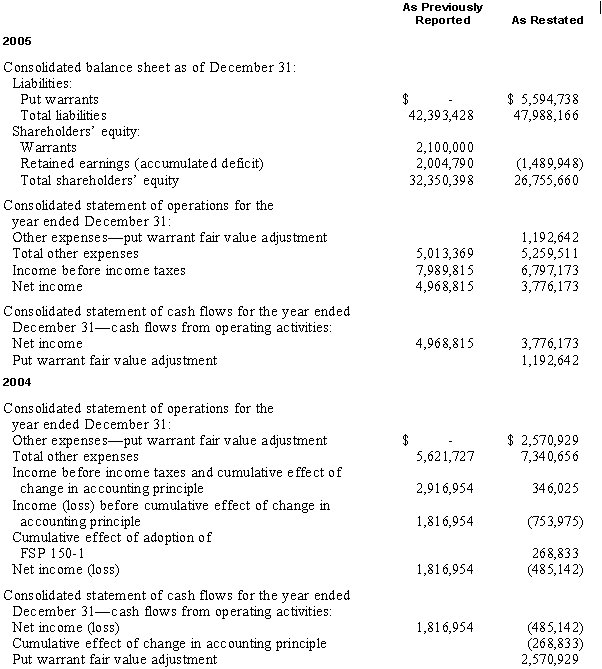
******
- 20 -